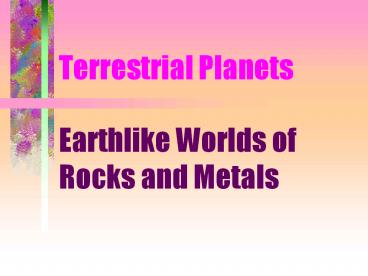Terrestrial%20Planets - PowerPoint PPT Presentation
Title:
Terrestrial%20Planets
Description:
Mass and radius give mass/volume ... Lowlands: Undulating lava plains ... Lowlands: Cratered southern hemisphere (wind erosion now; water erosion in past) ... – PowerPoint PPT presentation
Number of Views:18
Avg rating:3.0/5.0
Title: Terrestrial%20Planets
1
Terrestrial Planets
- Earthlike Worlds of Rocks and Metals
2
Earth Model Planet
- Mass and radius give mass/volume bulk density,
about 5.5 times water - Key to composition, internal structure, verified
by seismic waves - Metals bulk density about 8, rocks about 3 earth
about 50-50 metals/rocks
3
Density Layers
- Core (metals)
- Mantle (dense rocks)
- Crust (less dense rocks)
- Partially or fully melted to separate by density
(differentiation)
4
Internal Energy
- Heat now at surface about 0.1 watt per square
meter - Internal energy stored from formation (by
accretion) plus radioactive decay gt larger in
past - Infrared from surface escapes to space, lost
forever
5
Energy Outflow
- Volcanism Molten material, gases rise to
surface adds to crust and atmosphere - Tectonics Any motions of the crust plate
tectonics involve large-scale motions
6
Age of Earth
- Radioactive dating Decay of isotopes with long
half-lives - Gives elapsed time since rock last melted and
solidified (remelting resets clock) - Oldest rocks about 4 Gy 0.5 Gy for earths
formation gt about 4.5 Gy for earths age
7
Relative Ages
- Oldest regions of crust Central regions of
continents (few Gy) - Youngest regions of crust Seafloor (few hundred
My) - Upwelling of materials from mantle by convection
- Constantly renewed
- Migration of continents
8
Mercury Surface
- Cratered highlands (4 Gy old)
- Large impact basins, plains with few craters (3
Gy old) - Ratio volcanic/cratered terrain about 0.3 same
as moons ratio gt evolution similar to moons - Dead planet now
9
Venus Surface
- Highlands Volcanic and local (not global!)
tectonic rises - Lowlands Undulating lava plains
- Ratio volcanic/cratered about 4 similar to
earths ratio surface evolved as much as earths
10
Mars Surface
- Lowlands Cratered southern hemisphere (wind
erosion now water erosion in past)) - Highlands Volcanic regions in northern
hemisphere (2 Gy old) - Ratio volcanic/cratered about 0.7 between moon
and earth
11
Interiors
- Moon Rocky core cool
- Mercury Large cold metal core, thin rocky mantle
- Mars Small metal core, large rocky mantle
- Venus Large hot metal core interior much like
earths
12
Comparative Evolution
- Mass matters!
- More mass, greater internal energy from
formation, radioactive decay - More mass, greater size (volume), ratio
mass/surface area less, lower rate of heat loss,
longer evolution
13
Evolution
- Formed by accretion of smaller bodies melted,
differentiated - Crust solidified cratered by impacts basins
formed (filled by volcanism, water on earth) - Loss of internal energy End of evolutionary life

